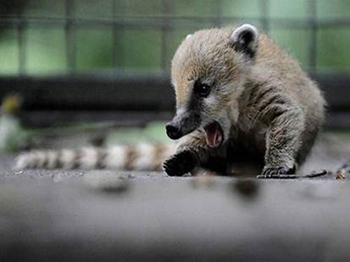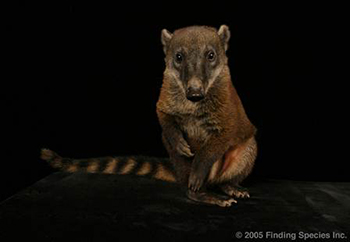Coatimundi
Nasua nasua

Taxonomy:
Kingdom: Animalia
Phylum: Chordata
Subphylum: Vertebrata
Class: Mammalia
Order: Carnivora
Suborder: Fissipedia
Family: Procyonidae
Name (Scientific): Nasua nasua
Name (English): South American Coati
Other Names:
Coatimundi
Coati
Brazilian weasel
Morphology:
The coatimundi has a long snout, an elongated body and a long bushy tail banded with dark rings. Their tail may add 32-69 cm in length and are used for balance. The area around the nose is rich in sensory receptors which result in an extremely heightened sense of smell. Numerous muscles allow great flexibility of the tip of the snout, which is used to poke into crevices and to seek out prey (Emmons, L. & Helgen, K. 2008). Coatis curl their snouts above the water surface when drinking. Male coaties are much larger than females. The coat color varies from yellowish brown or reddish brown to black. The ears are small and rounded. The head-body length of this species is 41 to 67 centimeters, they weight from 3.5 to six kilograms. These animals use their strong arms and forelimbs to dig out food from under rotten logs. The forefeet contain long, powerful, blunt and slightly curved claws, making coatis excellent diggers and shredders. Running speed may reach 27 km/h, and one author noted that coatis can run for three hours when hunted by dogs. Coatis, being excellent climbers, can be found playing and resting in the trees.
 Habitat:
Habitat:
The species is an occupant of forested habitat. It has been reported from multistratal deciduous and evergreen rainforest, riverine gallery forest, xeric chaco, cerrado and dry scrub forest (Eisenberg, J., and K. H. Redford.1999.). It is found over a wide altitudinal range, with Andean individuals found at elevations up to 2,500. It is essentially diurnal in its activities. Active both day and night, the coati is a forest dweller and an agile tree climber. Adult males are solitary, while females and immature males travel in groups up to 30 individuals (Emmons, L. & Helgen, K. 2008.). The main threats to this species are habitat encroachment and hunting. Additionally, there is a small demand for these creatures as pets.
Feeding:
They are omnivorous and primarily eat fruit, invertebrates, other small animals and bird's eggs (Emmons, Louise (1997).
Life Cycle & Reproduction:
All females in a group come into heat simultaneously when fruit is in season. This period may shift slightly from year to year. Actual mating may occur in the trees or on the ground. BCI females may first breed at 22 months of age, although a few females may not breed until 46 months. All females may breed, or as few as 20% may breed, depending on ecological conditions such as food availability. Males may mate at 34 months of age, but due to intense competition between males, an individual may not successfully breed until his 4th or 5th year, if ever (Emmons, Louise. 1997). Young coatis weigh about 180 grams at birth, with body lengths of 255-275 millimeters. They open their eyes after 4-11 days, and begin to walk and hold their tail erect at around 11 days. Teeth begin to erupt at about 15 days. By 40 days, when females and their newborn young rejoin the band, juveniles weigh approximately 500 grams (Eisenberg, J., and K. H. Redford.1999.).
Ecological Importance:
There is currently no major ecological importance of Nasua nasua.
Summary of recent research:
The respiratory mechanics of the coatimundi and woodchuck were studied to determine whether mechanics play any role in the differences in breathing pattern observed in these two mammals of similar body size. Although static respiratory system compliance was less and lower airway resistance was greater in the woodchuck compared to the coati there was no significant difference in deflationary time constant that could contribute to the difference in expiratory time. Studies concluded the differences in breathing pattern are more likely related to differences in the control of breathing than to differences in respiratory mechanics (Boggs, D F, and C G Irvin).
Personal Interest:
When first seeing this animal my opinion of it was, it resembles a skinny raccoon. I immediately gained interest in the coatimundi because of my curiosity as to know if it were related to the raccoon. The appearance of a juvenile animal resembles a baby squirrel, which I find to be extremely cute.
Citations:
Please note that the following references may have either been removed or relocated by the webpage owners since the time this student report was created.
Boggs, D F, and C G Irvin. “Respiratory mechanics of the coatimundi and woodchuck.” Respiration Physiology 89.2 (1992) : 147-155.
Emmons, L. & Helgen, K. 2008. Nasua nasua. In: IUCN 2011. IUCN Red List of Threatened Species. Version 2011.2
Eisenberg, J., and K. H. Redford (1999). Mammals of the Neotropcs: The Central Neotropics. Vol. 3, p. 288. ISBN 0-226-19541-4
Guzman-Lenis, A. R. (2004). Preliminary Review of the Procyonidae in Colombia. Acta Biológica Colombiana 9(1): 69-76
Emmons, Louise (1997). Neotropical Rainforest Mammals, A Field Guide, 2nd Edition. pp. 153–154. ISBN 0-226-20721-8.
Links:
Please note that the following links may have either been removed or relocated by the webpage owners since the time this student report was created.
http://www.infoplease.com/ce6/sci/A0812686.html
http://saveamericasforests.org/Yasuni/Biodiversity/Coati.html
http://thewebsiteofeverything.com/animals/mammals/Carnivora/Procyonidae/Nasua/Nasua-nasua.html